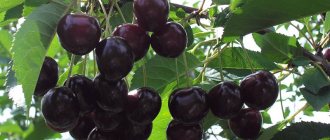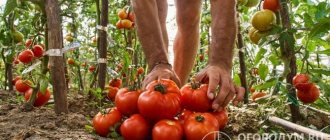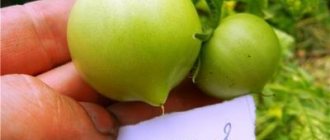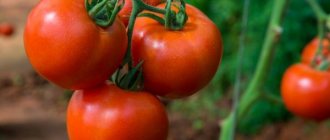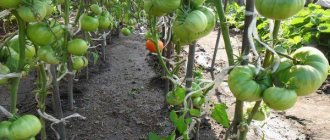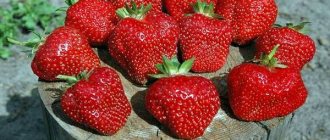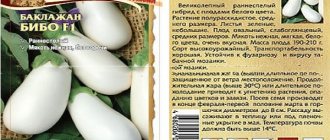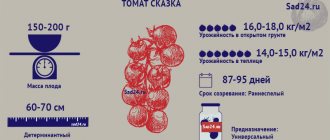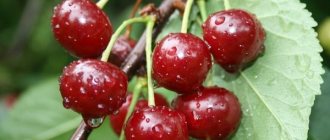Description of cherry Octave
The species is zoned in the Central District. But the description given by the breeders of the Octava cherry variety is one thing, and the reviews of the gardeners who grow it are completely different. According to them, with climate change it has proven itself well in the northwestern regions, as well as in Belarus.
The Octava cherry variety is a medium-sized tree. Their height rarely exceeds two meters. The crown is round, formed by medium-sized skeletal branches and thin shoots at the age of 1-2 years. Healthy young shoots have smooth bark with a slight glossy sheen, predominantly a rich red-brown color. The skeletal branches acquire some roughness and a lighter shade.
The leaves of the Octave cherry are small and elliptical. The leaf blades have finely serrated edges, curl slightly along the central vein, and resemble a boat shape. Their surface is matte, rich green, with yellowish veins.
Octave cherry inflorescences form on thin fruit branches, mainly on peripheral shoots. On the one hand, this simplifies harvesting, on the other hand, it requires some skill when pruning shoots and forming the crown.
The sepals themselves are quite large, cup-shaped. They consist of 6 oval petals of snow-white color, collected around bright yellow elongated anthers and stamens. Flowers are collected in clusters of 3-5 pieces each. According to descriptions and photos of gardeners, the Octave cherry variety resembles a white cloud at the moment of flowering.
The berries of the Octave cherry are medium in size and have a flat-round shape. Their weight is about 4 grams. The color is dark cherry, almost black at the stage of full biological maturity. The fruits themselves are dense, fleshy, quite juicy, with a small stone that is easily separated from the pulp. Octava cherry, according to gardeners, is sweet, with slight notes of light sourness and tartness. The tasting score according to various sources is within 4.3-4.7 points out of five possible ones.
The berries are easily removed from the branch and come off the stalk, remaining dry. At the same time, Octave cherries are not prone to cracking berries or baking them in the sun. No one who has encountered the cultivation of this variety talks about the shedding of ripe berries. This is a very important point for working summer residents.
Cherry. Who replaced Vladimirskaya and Lyubskaya
There can never be too many cherries. However, owners of small gardens cannot afford a real cherry orchard - the area is limited, they want variety, and the trees are quite large. So they are racking their brains about which variety to choose so that the fruits are tasty and the yield is high. And new varieties continue to persist, competing with the old Vladimirskaya, Lyubskaya and Shubinka.
The problem with cherries is that they are a cross-pollinated crop. According to their ability to set fruit from pollination with their own pollen, cherry varieties are divided into self-fertile, partially self-fertile and self-sterile. But even self-fertile varieties form 20–40% of the fruits of the total number of flowers on the plant, and sterile varieties form less than 5%. Therefore, at least 2 varieties with close flowering periods should grow in the garden.
Some clarifications. Low-growing varieties are 2-2.5 m high, medium-growing varieties are 3-3.5 m high; early-bearing - begin to bear fruit in the 3rd year after planting; deviations from this norm are indicated in the characteristics.
Self-fertile
Brunette. Medium ripening period. Recommended for the Central region.
The trees are medium-sized, the crown is spherical, spreading. Fruits on last year's growth and bouquet branches. Winter hardiness is above average. Resistance to moniliosis and coccomycosis is average.
The fruits are medium-sized (3.5-3.8 g), round, dark burgundy, almost black. The pulp is tender, juicy, the juice is dark red, the taste is sweet and sour, dessert.
Bulatnikovskaya. Medium ripening period. Recommended for the Central region.
The tree is medium-sized, with a rounded, slightly raised crown. Fruits mainly on bouquet branches. Winter hardiness is high. Resistant to coccomycosis and moderately sensitive to moniliosis.
The fruits are medium-sized (3.2 g), rounded-flattened, dark red, the flesh is red, dense and tender, the juice is pink, the taste is sweet and sour.
Youth. Medium ripening period. Recommended for the Central region.
Trees or bushes are low-growing in height, the crown is rounded. Fruits on last year's growth and bouquet branches. Winter hardiness is above average. Resistance to moniliosis and coccomycosis is average.
The fruits are large (4.5 g), oval, dark burgundy, the flesh is red, dense, juicy, the juice is dark red, the taste is sweet and sour, dessert.
Octave. Medium ripening period. Recommended for the Central region.
The trees are low-growing, with a round, compact crown. Fruiting on annual growths. The winter hardiness of the tree is average, the flower buds are high. Resistance to coccomycosis and moniliosis is average.
The fruits are medium, weight 3.9 g, dark cherry, almost black, round-flat. The pulp of the fruit is dark cherry, juicy, tender, the juice is dark-colored. The taste is good, sweet with a tart note.
Tamaris. Late ripening. Recommended for the Central Black Earth and North Caucasus regions.
The tree is low-growing, with a wide-rounded, raised, sparse crown. Fruiting on bouquet branches. Winter-hardy, disease-resistant.
The fruits are large (4.8-5.0 g), with a flat-rounded top, dark red. The pulp is dark red, with purple juice, dense and tender, very juicy, sweet and sour.
Chocolate girl. Medium ripening period. Recommended for the Central region.
Tree 2-2.5 m high with a compact raised crown. Fruiting is mixed.
Winter hardiness is good. Susceptible to coccomycosis and moniliosis.
The fruits are wide-round, weighing 3.5 g, almost black, the flesh is dark red, medium density, the juice is dark red, the taste is sweet and sour.
Partially self-fertile
Anthracite. Medium ripening period. Recommended for the Central region.
The tree is low-growing, the crown is spreading, it bears fruit on last year's growths and on bouquet branches. Winter hardiness is high. Coccomycosis and moniliosis are affected to a moderate degree.
The fruits are large (4.1-5.0 g), wide-heart-shaped, almost black. The pulp is dark red, medium density, juicy, the juice is dark red, the taste is good, sweet and sour.
Gurtievka. Early ripening. Recommended for the Central Black Earth region.
The tree is medium-sized, the crown is wide. Fruits on bouquet branches and growth from last year. Winter hardiness is good. Resistant to coccomycosis.
The fruits are rounded and flattened, weighing 3.6-4.0 g, dark red. The pulp is red, juicy, medium density, red juice, sweet and sour taste.
Dessert Morozova. Early ripening. Recommended for the Central Black Earth region.
The tree is medium-sized, the crown is spreading. Fruiting occurs mainly on annual growths. Winter-hardy. Resistance to coccomycosis is average.
The fruits are large (4.6-5.0 g), round, red, the flesh is red, soft density, delicate consistency, juicy, dessert taste with a slight sourness.
Zaranka. Medium ripening period. Belarusian variety. It is being tested in the Central region.
The tree is medium-sized, with a pyramidal, raised crown. Fruiting occurs on the previous year's growth and bouquet branches. Winter hardiness is high. Resistance to coccomycosis and moniliosis is average.
The fruits are round, medium size (4.5 g), dark red. The pulp is dark red, medium density, juicy, pleasant sweet and sour taste
Novella. Medium ripening period. Recommended for the Central Black Earth region.
The tree is medium-sized, the crown is round and spreading. Fruits on bouquet branches and growth from last year. Winter hardiness is high. Highly resistant to coccomycosis and moniliosis.
The fruits are large (4.5-5.0 g), almost black, the pulp is dark red, medium density, the juice is dark red, the taste is good, sweet and sour.
Northstar. Late ripening. An American variety, recommended for the Central and Central Black Earth regions.
The tree is low-growing, with a round, compact crown. The fruiting pattern is mixed. Winter hardiness is average. Resistant to coccomycosis and cluster blight.
The fruits are round, with an average weight of up to 4.5 g, dark red, red flesh, delicate consistency, very juicy, red juice, sweetish-sour taste.
Radonezh. Medium ripening period. Recommended for the Central region.
The tree is medium-sized with a short trunk and a round-oval crown. Fruits on annual growth. Frost resistance is high. Resistant to coccomycosis and moniliosis.
The fruits are large (4 -4.8 g), rounded dark red, the pulp and juice are dark red, the taste is delicate, sweet and sour.
Self-sterile
Crane. Late ripening. Recommended for the Central and Northwestern regions.
The tree is low-growing with a paniculate crown. Fruits on annual growth. Winter hardiness is high. Resistance to coccomycosis and moniliosis is average.
The fruits are large (5-5.5 g), beautifully shaped, dark red, the pulp and juice are dark red, medium density, dessert taste, sweet and sour.
Robin. Late ripening. Recommended for the Central, Middle Volga and Ural regions.
Tree of medium vigor, spherical crown. Fruits mainly on last year's growth. Winter hardiness is high, resistance to coccomycosis is average, and resistance to moniliosis is weak.
The fruits are above average size (3.5-4.0 g), round, dark red, the flesh is dense, juicy, the juice is dark red, the taste is sweet and sour.
The beauty of Tataria. Early ripening. Recommended for the Middle Volga region.
The tree is medium-sized, the crown is round, fruiting is of mixed type. Winter hardiness is average. Resistance to coccomycosis is average.
The fruits are large (4.5-4.8 g), wide-round, dark red, the pulp and juice are dark red, the pulp is medium dense, juicy, the taste is good, sourish-sweet.
Domestic. Late ripening. Recommended for the North-West region.
The tree is small, with a round-oval crown, of medium density. Mixed fruiting. Winter hardiness is high. Resistance to coccomycosis and moniliosis is average.
The fruits are round, medium in size (3-3.5 g), dark red, the flesh is dark red, tender and juicy, with a good sour-sweet taste.
Characteristics of the variety
Octave cherry has average winter hardiness. It is believed that shoots tolerate severe frosts worst of all. They can be damaged at air temperatures of 12-15 degrees below zero. The root system is more stable. The buds are practically not damaged by frost. Its flowers also do not suffer from drops in spring night temperatures to 1-3 degrees below zero. This gives Octava cherries a great advantage over other varieties cultivated in the middle zone, since return frosts have virtually no effect on yields.
Attention!
To prevent shoots from freezing, Octave cherries are planted on the southern sides of high hedges or buildings. Choose places between buildings located from east to west, but in such a way that they do not shade low trees.
The variety is relatively drought-resistant. However, in dry years it requires regular watering. Excess moisture, leading to soaking of the root system, significantly reduces the yield of cherries, often causes diseases and causes the death of the plant.
Pollinator varieties
Octave cherry breeders and gardeners have been arguing for many years about the self-fertility of the variety. The first believe that it does not require planting pollinator varieties nearby. Gardeners are confident that planting varieties such as Lyubskaya or Shokoladnitsa nearby will help increase productivity.
The Octave cherry itself can act as a pollinator for cherries with similar flowering periods. But self-fertile varieties are rarely used in this role. The fact is that pollination takes place inside the bud, and when it opens, not so much sprouted pollen is formed.
Features of fruiting
The Octave cherry begins to bear fruit at 3-4 years of age. Although flower buds are formed a year after planting. However, it is recommended to cut them off to give the tree time to fully take root and gain strength.
It is believed that Octave bears fruit annually and evenly. But many owners of garden plots note wave-like fruiting according to the pattern one year after another. It cannot be said that the tree does not bear fruit after a year. But the yield is slightly reduced. Whether this point is related to the characteristics of the Octave variety or weather conditions is unknown.
Planting and caring for the Octave cherry variety
Cherry Octave: photo of the variety
Octave cherry is considered one of the most convenient varieties, as it is completely unpretentious. At the same time, there are still some features and subtleties that gardeners and gardeners take into account. If the gardener uses some intensive technologies, then there are some characteristic features that are still worth taking into account. Only by creating a favorable microclimate for planting can a worthy and significant result be achieved.
Landing
1. Site preparation
The holes for planting Octave cherry seedlings should be up to half a meter deep, and their diameter varies from half a meter to sixty centimeters.
Again, you should focus on the size of the seedling itself, on the size of the root system - the roots should be comfortable in the hole, not cramped, there should be free space.
If this is not a single, but a group planting, then there should be a distance between the seedlings, which is about three meters. In general, it is worth considering that plantings need enough space in order to grow normally and actively develop.
In addition, when the trees grow taller, they will not shade each other, which means each cherry will have sunlight and space for growth and development.
When a gardener prepares a hole, he must mix the soil he takes out of it with humus in a 1:1 ratio. You can also add potassium chloride, superphosphate, and ash there to normalize the general condition of the soil and make it more saturated and nutritious for cherry growth.
If the area suddenly has heavy and clayey soil, then river sand should be added to it before planting cherries. Thanks to it, the soil will become looser, and this will have a beneficial effect on future planting.
Octave cherry needs the root system to be constantly saturated with moisture and oxygen, because only thanks to this the roots will not begin to rot and pathogenic bacteria will not develop on them.
2. Preparation of seedlings
Before planting, seedlings are carefully inspected for damage or disease.
If suddenly the root system or its parts are affected, then they must be carefully removed.
The cut areas must be treated with activated carbon so that bacteria no longer penetrate there.
Next, the seedling is sent to open ground, it is planted in a hole, and a peg is installed nearby. The stake is necessary in order to support the planting, and also to ensure that when the wind blows, the seedling does not break or be damaged.
The root collar should protrude about three to four centimeters above the soil surface.
3. The complete algorithm for planting Octave cherries is as follows:
- the gardener selects healthy and healthy seedlings and examines them from all sides. Before planting, the seedlings are placed in a growth stimulator - root for several hours;
- The seedling is placed in a pre-prepared hole, which is filled with fertile soil. A peg is driven into the center, which will become a future support for planting. The mixture is poured around the peg in the form of a mound, and the seedling itself is placed on the mound. Experienced gardeners recommend planting not alone, but together - one person will support the seedling from above, and the second will carefully straighten the roots;
- Then they begin to add soil to the roots; this should be done carefully, constantly shaking the seedling. This must be done to ensure that air pockets do not form around the roots, which will lead to the formation of cavities and the development of pathogenic bacteria;
- The seedling is tied to a peg, this is done carefully. This can be done from the north side of the peg strictly vertically - the seedling should not deviate anywhere, otherwise this will lead to the tree growing unevenly and unevenly.
4. Actions after planting the Octave cherry
Then the gardener monitors how the seedling takes root, how it adapts and takes root in new conditions. It is extremely important to maintain the vital activity of the planting and mulch the tree trunk circle. Mulch performs several functions - it protects the planting from attack by bacteria, and also prevents moisture from evaporating from the soil too quickly. In addition, thanks to mulch, the required amount of heat is retained in the soil, which is also very important for the overall condition of the planting.
After planting the seedling has been completed, an earthen roller should be made around the entire circumference. It should be located approximately 25 centimeters from the main trunk, and thanks to this roller the space will be designated for full watering of the plant.
It is recommended to water the seedlings with settled water at room temperature. In general, the root system of a plant is considered very delicate and vulnerable, and therefore it is still recommended to be very careful about both the watering process and fertilizing.
Agrotechnical measures for cherries of the Octave variety
Cherry Octave: photo of the variety
Octave cherries do not tolerate transplantation, so initially the gardener should make sure that the planting area is as comfortable and well-lit as possible.
To water one cherry seedling, the gardener will need about two or three buckets of water, but be sure to take into account temperature indicators and conditions, because otherwise the planting will feel less comfortable, and in general the growth and development of this cherry seedling may noticeably slow down. Because of this, the fruiting periods will shift.
When the tree matures, the agricultural technology can be slightly changed. For example, it is worth increasing the number of waterings - at least three times per season. You should also focus on climatic and weather conditions, the amount of precipitation and the duration of dry periods.
Only taking into account all the external features, as well as taking into account the state of the planting, will it be possible to create the most favorable watering schedule , which will meet all planting requirements:
- The first watering should be scheduled for the time when flowering ends.
- The second time the cherries are watered after the fruits have gradually filled in and when they begin to gradually ripen. At this time, they really need watering so that they can become juicy and large - something that corresponds to the varietal indicators and characteristics.
- The third watering should be carried out at the very beginning of October, after the leaves have fallen and the planting must be prepared for the winter period.
You should remember to loosen the soil after watering throughout the growing season. Also, the tree trunk circle should not only be loose (to allow oxygen and moisture to pass through), but also cleared of weeds and other excess vegetation.
This may not have the best effect on the condition of the plantings, their characteristics and properties, and therefore it is still worth paying as much attention as possible to some issues and issues related to the hygiene and aesthetics of the sites.
Let's talk a little about feeding. In the first couple of years, planting will not require the application of fertilizers and fertilizing at all for the reason that they will be saturated with all the necessary substances and components from the saturated and enriched soil.
But after two or three years, it is still necessary to begin adding additional fertilizers and substances so that the plantings can feel much more comfortable. Typically, fertilizers are applied in the autumn, before the gardener orders in-depth digging of the garden plot. So, for one cherry tree we will need to apply potassium fertilizers, phosphorus fertilizers (all these fertilizers are applied mainly in dry form).
In early spring, it is necessary to make the soil saturated with nitrogen-containing components. This will require about fifty grams of fertilizer, which will be ideal for saturating the planting and creating the most favorable conditions for it.
You should not be overzealous with fertilizing, as you can quite overfeed the planting and cause harm to it. And in general, experienced gardeners say that it is better not to feed the planting more than to create satiety conditions for it, in which the cherry will experience discomfort.
When the Octave cherry reaches the age of two years, the crown should begin to be formed .
To do this, the branches are pruned. They carefully inspect the planting, shorten the growths so that the plant looks not just neat, but also healthy. If the Octave cherry becomes quite old, then gardeners are recommended to carry out anti-aging pruning. Thanks to it, the tree can be given a second life.
It is worth keeping in mind that, in principle, trees tolerate these procedures quite calmly and recover normally after pruning and shaping.
Frost protection is another important requirement that gardeners must maintain. The fact is that the winter period can be very harsh, both for adult plants and young seedlings.
Therefore, it is necessary to protect plantings using materials such as glass wool and roofing felt, reeds, spruce forests, and thick paper.
If the trunk has been damaged by rodents, pests, or mechanically by the gardener himself, then the damaged area is carefully cleaned with a knife and lubricated with garden varnish to prevent further penetration of infection into the bark. It is better to tie the trunk on top with a dense material that will allow a small amount of air to pass through.
In general, if you create such conditions for planting, you can reduce the risk of damage, freezing or other negative effects from planting. The main thing is to be able to recognize in time some negative manifestations on the part of the variety, some of its signals that it is worth being more attentive to agrotechnical aspects, and then the gardener will achieve an excellent and significant result.
Let's talk a little about what pests and how they can be dangerous for a cherry tree.
In general, the Octava cherry variety is quite resistant , and with all this, it is quite rarely affected by such common diseases as moniliosis or coccomycosis, which can lead to the inevitable death of the plant.
Rodents can attack plantings, but not very often. The thing is that the bark of the tree is bitter, and its taste does not attract rodents or other pests at all. This is another advantage of planting, since it can restore itself.
The disadvantage of planting is that the tree becomes very tall, it is quite problematic to care for it, and it is not easy to harvest the resulting crop. Sometimes the fruits may fall off, but in rare cases - usually gardeners manage to collect most of the harvest, preserving it and using it for universal purposes.
Landing rules
It is advisable to plant Octave cherries in the spring months, but before active sap flow begins. Autumn planting is possible only in the southern regions.
To plant Octave cherries, choose well-lit places, protected from northern and eastern cold winds. More attention is paid to the mechanical composition of the soil, its acidity and the level of groundwater. They prefer light, well-drained sandy or loamy soils with a pH level close to neutral.
Attention!
You cannot plant Octave cherries in low places where moisture can accumulate during rains or melting snow. If groundwater is close, arrange good drainage or plant the seedling on a natural or artificial hill.
- For planting, prepare a hole about 50-70 cm deep and approximately the same diameter.
- A drainage layer of coarse crushed stone or pebbles is arranged at the bottom.
- The soil is mixed with compost, peat, humus. Add wood ash and potash-phosphorus fertilizers.
- A nutrient layer is arranged, and an Octave cherry seedling is planted on it.
The holes are closed, the soil is thoroughly compacted so that there is no air between the roots, and watered abundantly.
Cherry Troitskaya: description of the variety
Cherry Trinity: photo of the variety
The Troitskaya cherry bush has several trunks at once, about 5-6 pieces in height from 1.5 to 3 meters with a trunk of 60 cm and a width of 7-9 cm. The crown is oval, pointed at the top, quite dense, with a large number of leaves on branches. The branches are even, of moderate thickness; brown, slightly silvery, with slight pubescence. One-year-old branches have a length of 25 to 40 cm. The eyes are small, elongated, pointed at the upper tip, turned away and without irregularities.
The leaf is oval-shaped, medium-sized (8-9 cm long, 4-5 cm wide), dark green in color. The base and upper part of the leaf are pointed; the plate is without convexities, smooth and glossy (on perennial trees it can be matte), it also has a small number of glands and no pubescence. The edge of the leaf is uneven, with rounded jagged edges.
The stalk is not very long, about 1.6 cm, has a certain pigmentation, without stipules. A bouquet most often contains 5-7 small flowers, 2.6 cm in diameter, pink in color with curved petals, which sometimes block each other. The petals have an elongated oval shape, with a grooved surface and a tip divided in two. The stigma of the fruit is located below the anthers, there are about 32 stamens, the flower stalk is 2.5 cm long, the flower cup is in the form of a bell. Cherries bear fruit and bloom in a mixed variety: on young offspring - 30%, on the branches of inflorescences of two-year-old trees - 30%, on the same branches, but old wood - about 40%.
Growing rules
During the growing season, the Octave cherry needs:
- In early spring pruning. At this time, frozen shoots and branches growing inside the crown are removed. In the first 3-4 years, the plant also requires formative pruning. The result should be a crown on a low trunk, with 10-12 multidirectional skeletal shoots at a distance of 10-15 cm from each other.
- Watering is carried out in dry years. In normal years, cherries are watered as needed during flowering and fruit set. And also after the end of fruiting, when the buds are laid for the next year.
- In fertilizing with organic and mineral fertilizers. But if it is advisable to add mineral compounds annually, during the period of berry growth, then organic matter should be used once every 2-3 years. An exception is made for Octave cherries, which grow in regions with relatively cold winters, when the soil is mulched with compost for the winter.
- The root circle must be weeded and loosened. Mulching with sawdust will retain moisture at the roots and slow down the growth of weeds.
Growing Nord Star cherries
Every person who has his own garden sooner or later decides to acquire fruit trees. When choosing seedlings, you want to find an option that will not only bear fruit well, but also grow in a certain area. Among all the varieties that are widely represented on the modern market, Nord Star cherries deserve special attention.
Appearance of the plant
When considering the description of the appearance of this cherry variety, it is worth paying attention to the following characteristics:
- The tree is small in stature and has a compact, rounded crown of medium density. The bark of the trunk and branches is dark brown.
- The leaves are miniature, with a glossy shine, narrowly oval in shape.
- In one inflorescence you can count about 3-4 small saucer-shaped flowers.
- The petals of the flowers touch each other and have a broad oval shape.
The peculiarities of fruiting include the fact that its nature is mixed, and the harvest should be expected on branches aged from 1 to 3 years.
Features of the fruit
Nord Star produces berries that are unique in taste. The fruits of this type of cherry have the following distinctive characteristics:
- fruits are large, round in shape;
- the average weight of one berry is 4–5 g;
- the berries are dark red in color with a narrow funnel, a rounded top and a flattened side seam;
- the pulp of the fruit is fibrous, red, has a juicy and delicate texture;
- According to the taste characteristics, the berry is sweet and sour.
Landing Features
Cherries love well-lit areas and prefer neutral, well-drained soil. It is impossible to plant cherries in lowlands, because the close location of groundwater will destroy the root system. The peculiarity of the variety is that it is a light-loving plant that is afraid of strong winds, so it is necessary to select in advance the most favorable place, protected from drafts.
In order for the growth process to occur as well as possible, you need to prepare the soil before planting the seedling.
- Eliminate all weeds on the site.
- Meadow dark humus soil or ordinary black soil are suitable as ideal soil for cherries.
- To improve the soil, you can add compost to the soil before planting the tree or plow it with a small amount of manure.
- Fertilizers are added to the planting hole: 100 g of potassium fertilizers, 350 g of superphosphate and 2-3 buckets of humus.
No feeding will be required for the next 2-3 years.
After preparing the land, you can begin the main process. The depth of the hole where the cherry will be placed should be approximately 30 cm, the diameter about 60 cm.
If there is an earthen lump on the root of the seedling, then we do not destroy it, but place the root of the seedling in the hole along with the lump.
If the root system is open, you need to make a mound of soil in the hole, over which the cherry roots should be carefully distributed. After this, sprinkle everything with earth and compact it a little.
Cherry care
After planting the seedling, special attention should be paid to proper care. This applies to watering
because this type of plant is moisture-loving.
As soon as the tree is in the ground, it needs to be watered once a week; each seedling should receive about 20 liters of water, especially if the weather is dry and hot outside. Make sure that during watering the soil is moistened 30–40 cm deep.
At the stage of fruit ripening, watering should be reduced, as this can lead to cracking of the berries.
Annual pruning is recommended every spring before buds begin to appear. Due to weak branching at the age of five, only some branches need to be removed to thin out the crown.
Do not forget about sanitary pruning when you need to remove broken, diseased or dry tree branches.
Preparation for winter involves mulching the tree trunk circle with peat. In the northern regions, the cherry trunk is wrapped in spruce branches and a snowdrift is made around the trunk.
Disease Control
If you want to protect your own tree from the diseases listed above, at the stage of bud formation you can use:
- various tank mixtures of fungicides;
- insecticides Enzhio and Aktara;
- drug Horus.
After you carry out the first treatment, the next one can be carried out only after 10-12 days. For a young tree, 1 liter of the substance is enough, and for a tree with a large root system - about 2-3 liters.
Pest Control
One of the main pests of cherries of any variety is cherry cherry, so after the first individuals appear, you need to immediately treat the tree with any product prepared on the basis of imidacloprid. Among such means, Antikhrushch, Prestige, Aktara, etc. should be highlighted. It is necessary to treat the plant trunk and root system.
Reviews from gardeners about Octave cherries
Elena, 40 years old, Nizhny Novgorod Cherry Octava has been growing with us for about 15 years. And it only makes me happy. The harvests are stable, the berries are tasty. Currently it does not require special care. The main thing is to prevent thickening of the crown and carry out preventive treatments in a timely manner.
Olga, 45 years old, Smolensk Cherry Octava is a good variety. But with us it still requires quite careful care. She lacks warmth and sun. This may be why the harvest is smaller and the taste is more sour. Well, in winter there is a problem with shelter. Especially now, when the crown is already large.
Advantages and disadvantages of Octave cherries, description of the variety and history of origin
Detailed description of the Octave variety of cherries: large in size, juicy, almost black fruits weighing up to 4 g, medium ripening, with a very good taste, resistant to...
READ MORE: Benito tomato characteristics and description of the variety, yield photo
Features of planting and growing.
1. General information about cherries. Useful properties of cherries.
Cherry berries have been widely used in folk medicine since ancient times. Cherry is a dietary product; it increases appetite and improves the digestion process. Cherry fruits have a slight laxative effect.
Cherry has antiseptic and anti-inflammatory properties. Cherry juice quenches thirst at elevated temperatures. Traditional medicine recommends eating a kilogram of fresh cherries a day for a month, washing them down with 7-8 glasses of milk - this helps with arthritis and sclerosis. Cherry has a beneficial effect on the central nervous system; its decoction was used for mental illness and epilepsy.
The coloring pigment anthocyanin is highly digestible, as it is distributed throughout the fruit pulp. Cherries also contain a lot of coumarin, a substance that reduces blood clotting. This feature of cherries allows it to be used to prevent a number of complications of arterial atherosclerosis, and the successful combination of vitamins C, B1, B6, iron, magnesium, cobalt, and pigments in cherries is used to prevent and treat anemia.
Cherry – contains hematopoietic microelements: iron, copper, cobalt, which makes it possible to use it for anemia. Pectin substances help remove nitrogenous waste from the body. Cherry pulp contains bactericidal substances. Cherry juice is used for mental illness, arthritis, as a mild laxative, expectorant, thirst quencher and appetite enhancer.
Ascorbic acid in combination with P-vitamin active tannins and cherry pigments tone, strengthen blood capillaries, reduce high blood pressure, and increase the body's resistance to adverse effects, in particular, to increased background radiation. Eating cherries reduces the frequency and severity of heart attacks.
2. Choosing a place for cherries.
– Cherry requires a well-lit place. Otherwise, a decrease in the sugar content of the fruit and a general decrease in yield are possible.
– Cherry is far from the most frost-resistant crop. In this regard, it is recommended to plant next to country houses (between a barn and a bathhouse, a house and a fence). The best place for cherries is sunny, covered on the north side by a brick wall, which, when heated, will not only protect from cold winds, but also damage the tree.
– Cherry does not tolerate stagnant water. If there is a possibility of flooding on the site, the tree should be drained if possible or planted on a hill. Otherwise, the tree will have poor development or even death. The groundwater level should be at least 1.5-2 m.
– Cherry grows best on light sandy or loamy soils. On heavy clay or sandy soil, cherries most likely will not develop. In this case, a good landing hole is required. The acidity of the soil should be close to neutral: pH 6.5-7.0.
3. Cherry planting and care.
– Planting of seedlings can be carried out exclusively in the spring (for bare root plants), and from spring to September (for containerized plants).
– Cherry seedlings should not be buried when planted in the ground. The root collar (the place where the root enters the trunk) should be 5-7 cm above ground level.
– When buying a seedling in the spring, you can immediately prune the branches. You can't cut the roots. The more of them a young tree has, the faster it will take root. The roots can only be straightened.
– Almost all varieties of cherries growing in the Moscow region are considered self-sterile, that is, they need pollen from another plant to set fruit. Accordingly, you should keep this in mind and if you or your neighboring plot does not have another tree (another variety of cherry), you should purchase it immediately.
– The feeding area of one cherry tree depends on the rootstock: for vigorous rootstocks - 12 sq.m., for medium-growing rootstocks 9 sq.m.
– When planting cherries, either organic fertilizer (horse humus or humus), potassium chloride - 20 g, superphosphate 30-40 g are placed in the planting hole.
Further feeding. Application of mineral fertilizers before flowering: urea (10 g), potassium chloride (15 g), superphosphate (25 g) per 10 liters of water.
Fertilizers are applied based on 1 sq.m of fertilized tree area. Ammonium nitrate (15-20 g), superphosphate (30-40 g), potassium (10-12 g).
Almost all types of soil under cherry trees require liming. Lime is applied once every 5-6 years in the form of dolomite flour, ground limestone, etc. The application rate depends on the type of soil and ranges from 300 to 500 g. The minimum dose is applied on light soils, and the maximum on heavy soils.
Autumn fertilizing should be WITHOUT nitrogen content. On rich lands, fertilizing should not be done often, but on poor, sandy soils, fertilizers must be applied annually.
– In the first year after planting, it is recommended to cut off 80-100% of the flowers. This is necessary for better survival of the tree. In the future, it is necessary to pick off half of the crop at the greenfly stage - only the established fruit, several centimeters in diameter. This operation is called crop rationing.
READ MORE: Tomato Lyubasha f1: characteristics and description of the variety with photos and videos, yield of tomato f1, reviews from those who planted cherry tomatoes
– Watering cherries should be carried out 4-5 times a month at the rate of one bucket of water per adult tree, twice a day (in the morning and in the evening). Good watering is very important in the period June-July, when fruiting occurs, and at the same time flower buds are laid on the tree, forming the next year's harvest.
If there is a lack of moisture during this period, crop losses are possible both in the current and next year. Watering should be completed in August; otherwise, protracted growth of shoots may result, which can negatively affect the winter hardiness of the tree. However, in a dry year, it is necessary to continue watering so that the tree is saturated with moisture.
– Cherry has a tendency to form basal shoots. It should be cut close to the ground, since it wastes a large amount of nutrients, and there is almost never a harvest.
– Cherry is far from the most frost-resistant crop. In order to protect a young tree from early and severe frosts and snowless winters, it is recommended to mulch with horse humus in the area around the trunk, and also wrap the trunk with covering material or nylon tights (the material must allow water and air to pass through;
– To combat pests such as mice or hares, use the above-mentioned tights, or better yet, a special rodent net.
– The trunk circle is required when growing cherries. No plants should be planted in it; it must be kept free of weeds; constantly loosen. If desired, you can separate the tree trunk area from the lawn with a border strip (you cannot use iron sheets or concrete products for these purposes, as in the photo). To improve the winter hardiness of the tree in autumn, it is possible to mulch with horse humus (layer 5 cm thick).
4. Cherry pruning (briefly).
With proper pruning, you can not only regulate the tree’s yield, sugar content, and fruit size, but also save it from diseases.
– When planting, the branches of a young cherry seedling are cut off by one third. This will help him start establishing a crown faster.
– Cherry trees should be pruned annually in early spring before the buds open (usually the month of April). We do not recommend pruning in late fall.
– When cutting a branch completely, the cut is made at the very base (cut into a ring) - stumps should not be left.
– Branches with fruits that go down to the ground and even lie on it should be removed.
– It is necessary to thin out the tree annually to increase the yield and prevent the appearance of diseases and pests.
– Of the young shoots, only strong and erect ones should be left. Weak and crooked shoots should be removed. A strong shoot should not be confused with a spinning top. Such shoots are most often cut off completely, although they can also be used to form a good branch.
– You cannot take and cut off too many shoots at once, as this will be a very big shock for the tree. No more than 1/4 of the total mass of branches.
– When a tree reaches three meters, it is necessary to limit the growth of the tree. To do this, severely prune the branches growing upward, thereby allowing the side branches to develop.
Description of the Octave variety in the picture
Where to buy cherries in Moscow? Which cherry is best to plant in the Moscow region? Which cherry variety is the most delicious? We will help you find the answer to these and other questions! Just call or come to our nursery!
Advantages
- High yield (up to 40 kg per plant);
- Good frost resistance of flower buds;
- Pleasant taste;
- The harvest easily survives transportation;
- Fruits of universal use.
Flaws
No deficiencies were identified in the Octava variety of cherries.
